#Translation
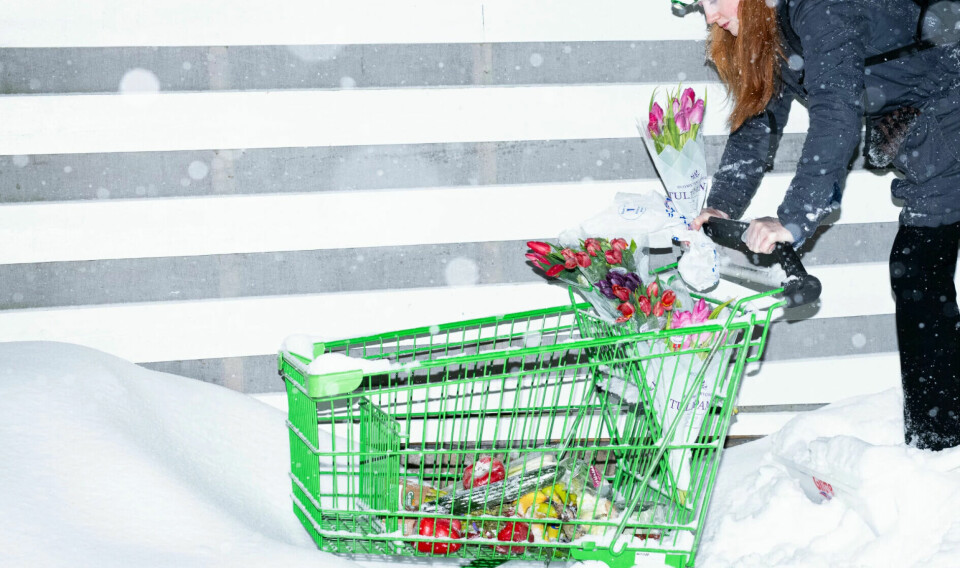
It is 01:36 in the morning on a Tuesday
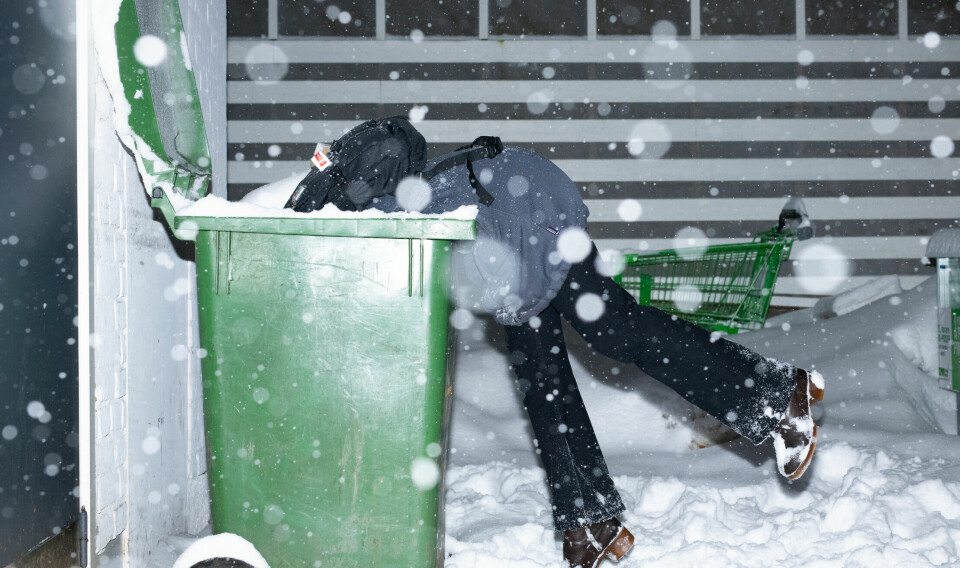
Prices are rising, but we are finding food elsewhere
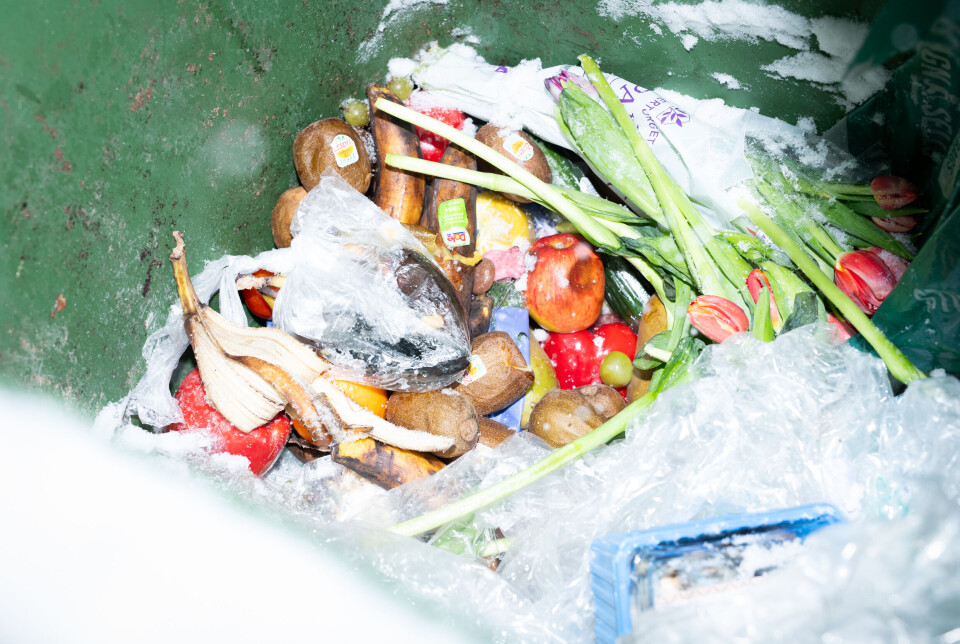
Can students survive by dumpster diving for their dinner?
Dumpster diving for dinner: A journey
This is a translation of the Norwegian article written by Freyja Eikrem Ims, with photographs by Tobias Schildmann Mandt (published on Universitas on February 24, 2024)
One late winter’s night we headed out on a mission to find solid tips for dumpster diving in Oslo. How much can you save, and where do you even start?
I often hear talk of fellow students who have dug around in grocery store’s rubbish bins and found themselves lots of exciting (and edible) food – but I've never been brave enough to try it. But now that everything has become so expensive, I'm willing to embark on an adventure to spend even less on my already tight grocery budget.
So I decided to get in touch with an experienced garbage-hunter to join me in search of edible food and rock-solid tips for students who want to be able to fill up their plates, but have never gone dumpster diving before.
Monday 22:46
As the clock approaches my usual bedtime, I find myself trudging across Scwheigaardsgate to meet my accompanying photographer and the only person I know of with dumpster-diving experience, Tobias. While I myself have never dumpster dived before, Tobias has done it a few times:
— Once I found 20 big bars of chocolate, and another time I found several kilos of expensive salmon!
Since I have no clue which grocery stores throw away the best or most rubbish (not to mention that this information is hard to find online), we decided to reach out to people we know and other people we had never spoken to before about some tips. These tips and tricks were given to us on one condition: The locations must remain secret. So the first tip from me is: Talk to others who know about dumpster diving and ask them directly about specific places to look.
Our tour guide Tobias took the various tips into account and planned an entire route for us. The journey begins by taking the metro line 3 towards Mortensund, departing at 23:01.
Well, that metro must have vanished in the tunnel, because it never arrived. Cut to fifteen-minutes later and we are on a metro. Then we are joined by the last member of the group: Isabel. So tip two: Expect to spend a lot more time than originally expected.
Monday 23:31
We arrive at our first destination after a long metro ride and we realise that we have not even planned our trip home. Tip three: Plan a journey home that you are guaranteed to reach in time.
— The last metro leaves at 00:21, and the last bus at 01:01, says Tobias looking somewhat doubtful.
But we don't have enough time to think about future problems and so we start searching through the first grocery store's rubbish. Excited, we run towards the container, open the lid, and are greeted by a totally empty bin.
— Alright then, we can head to the next store. How far away is it?
— Three kilometres, says Tobias and points far, far down the road, where the street lights end and the forest begins.
In the middle of the snow-filled forest we wander, and our courage is tested as we go further and further into the darkness with our empty bags. After a long journey through the forest and over a bridge, we arrive at a new grocery store and spot the bin standing there at the back of the premises.
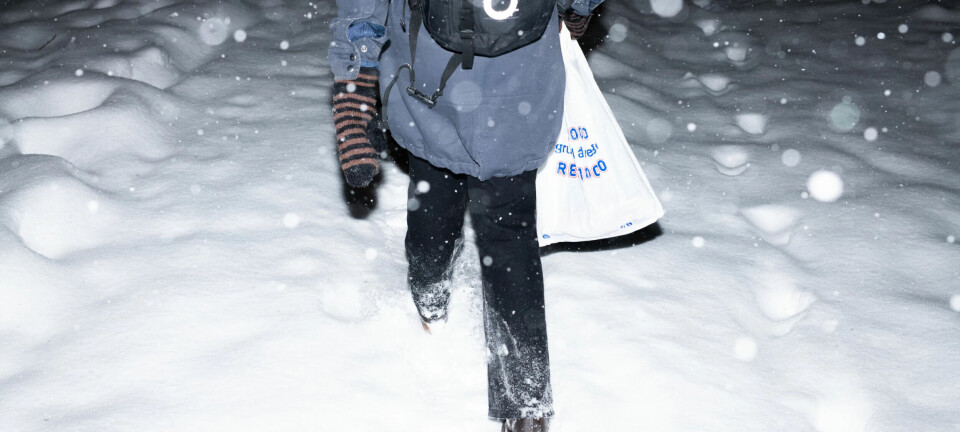
We rush towards the bin, tear off the lid
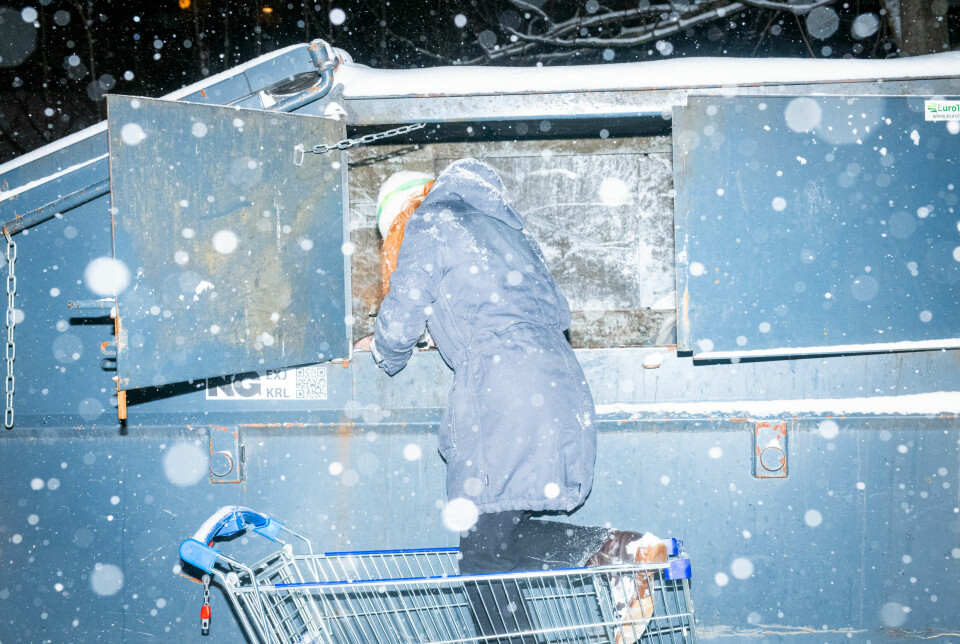
In the dumpster’s depth a treasure shines
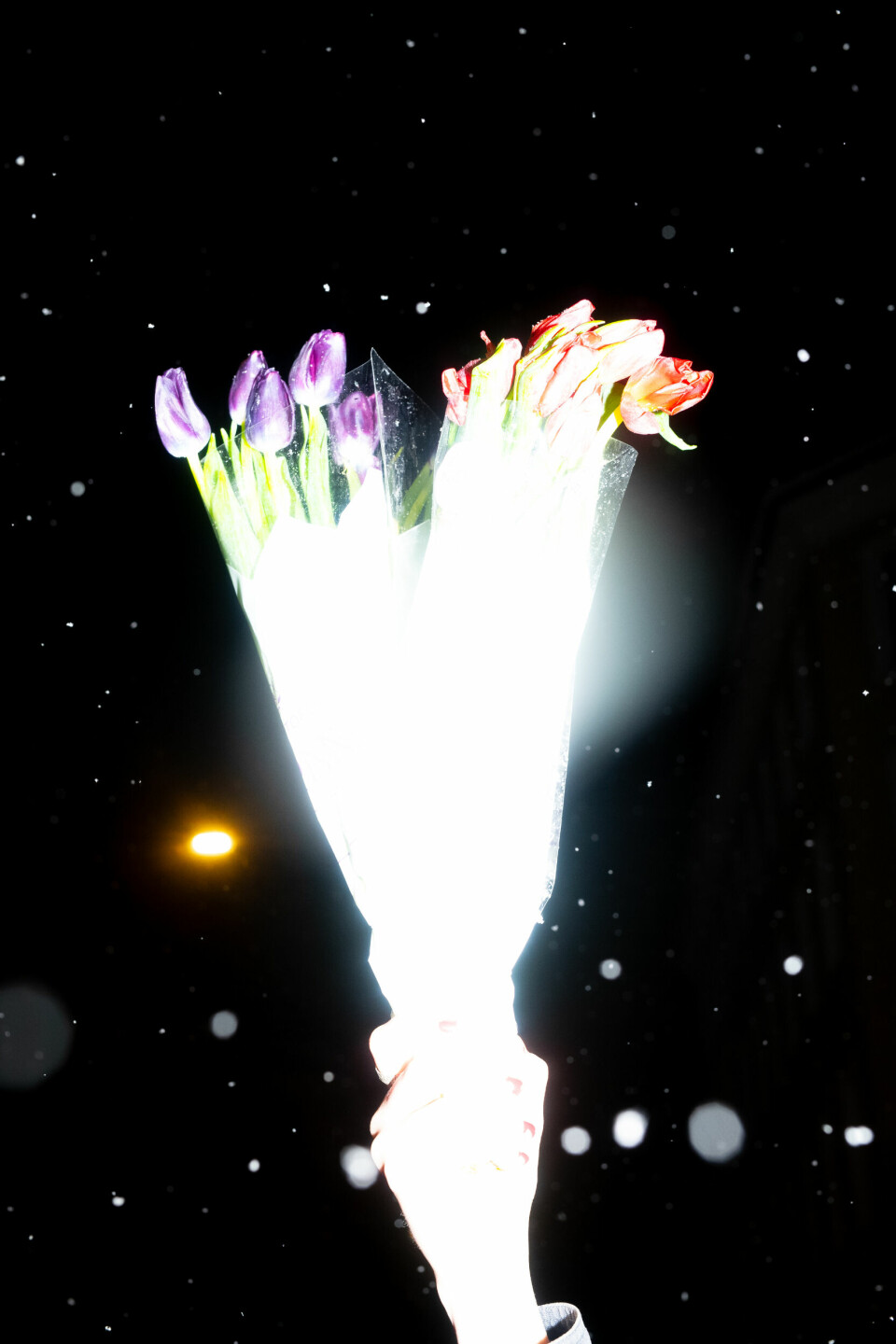
– It’s full of tulips!
I dive into the trash and find six bouquets of purple, orange and pink tulips. Gorgeous! At least the table decorations are secured! I take all the tulips that are there, because bouquets of flowers have become a real luxury in such expensive times.
We check under the tulips and spot something edible. An opened bag of sweets. The gang cheers, we've found free food!
We throw ourselves at the bag, but because it's already been opened and the sweets are wet, we're reluctant to give it a taste. Tip four: Do not eat already opened food. So instead, we dive back down and find some packets of bell peppers and other edible vegetables that we fill our food bags with. Then we happily move on to the next store.
Tuesday 00:35
We continue our journey on foot, breaching the cold night. I have a hole in my left shoe and even with two pairs of wool socks, I start to feel my foot is getting wet. In fact, soaked. But the dumpster hunt is not yet over.
The clock is ticking. The final bus heading to the city centre is soon departing, but we are so enraptured by the thought of more free food, that we ignore the tight deadline and head towards another grocery store.
— There must be something in that big container! shouts Tobias.
The previous shops only had small rubbish bins, but this store has a large container with a small hatch where all the rubbish hides behind.
— Jump in, you're the one who wanted to go dumpster diving, orders Tobias and holds the small garbage hatch open.
I have no choice but to sacrifice myself, so I jump in to do some real scavenger-hunting journalism. And I wonder if we will find anything interesting this time around! Two expired cheese and ham salads. We only frown at them because two of us don’t eat meat, and the other does not eat carbohydrates. This is one of the big challenges that comes with dumpster diving alongside expiration dates, you might just find food you don't want or can't eat. So, tip five: Forget your taste preferences and don't be picky.
Further down in the container’s darkness, I find an insane amount of lomper (norwegian flat potato bread), all of which have expired.
— Well I can't eat them in any case, whines the low-carb fellow.
I, on the other hand, praise the dumpster gods for all the carbs, because it doesn't seem like we're getting any protein. Next to the lomper, I find fresh vegetables, so I am satisfied. I climb out of the container with my shoes soaked in garbage juice and a growing dread of what the journey home will be like.
Tuesday 01:23
We make our way to the last grocery store that someone tipped off. Everyone is tired and wet. We go around the outside of the whole store, but they have locked the treasures inside. The next metro or bus home doesn't leave until 05:00. We sit down in the snow and think; What have we done?
What got me here was my curiosity about dumpster diving and how it plays out. With food prices increasing by 8.8 percent in the past year, I wanted to look for food elsewhere than on the store’s shelves. But here I sit with my gang, bags full of bell peppers and tulips at 01:36 in the morning with no way home. We didn’t go dumpster diving by car – because neither of us owns a car (or even has a licence) – but also because we wanted to see how easy it is to dumpster dive using public transport. Tip six: Always bring a tent.
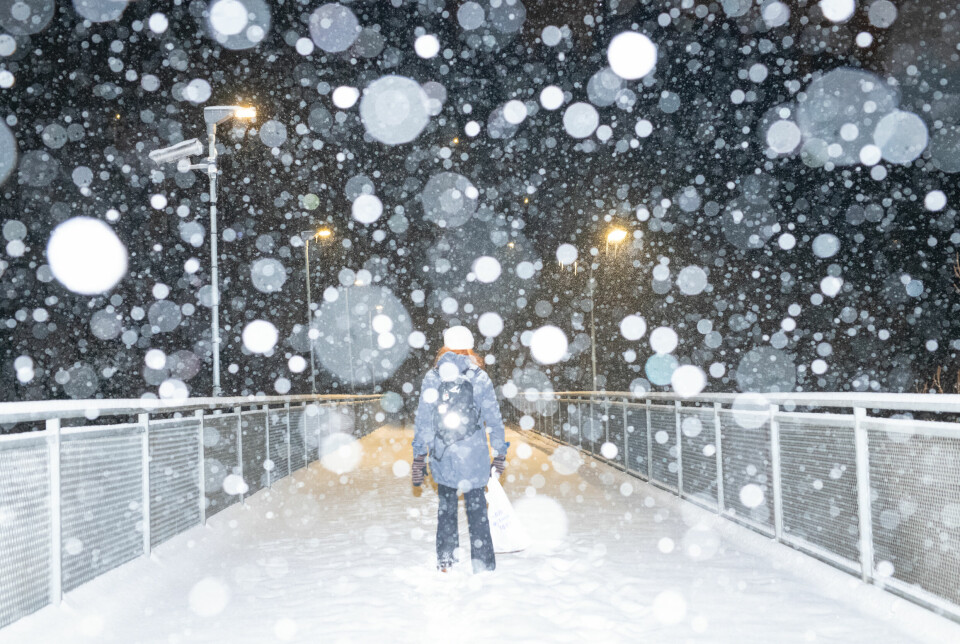
— Shall we take a Bolt? (Translator’s note: Bolt is a ridesharing company in Norway)
Everyone nods, and we check if anyone is available to pick us up. But no one responds to three little journalists with their three bags of rubbish.
— Do you know of anyone who lives nearby whose sofa we can crash on? says Tobias with sleepy eyes and hair full of icicles.
Isabel and I shake our heads, and Tobias starts chipping away at the icicles from his head. After checking all possible taxi apps, at 01:50 we finally find a Bolt willing to take us home. At 01:53 we are sitting in a warm car, with frostbitten toes, Slim Shady at full blast and the trunk filled with presumably edible rubbish.
Tuesday 14:49
After a short night's sleep, we met up again on Tuesday afternoon at Tobias' apartment.
Yesterday's finds are as follows: Three red and two yellow bell peppers, a bag of small snack-sized peppers, two sweet bell peppers, a head of cauliflower, a pack of salami, a bunch of cherry tomatoes, three leeks, two bunches of spring onions, one and a half sweet potatoes, three quarters of a frozen cucumber, a mushroom, a pack of strawberries, four packets of lomper, six bananas, two handfuls of celery, a passion fruit and two cheese and ham salads.
— But, where are the tulips?
— Haha, I forgot to bring them in from the balcony, says Tobias and points to a bag covered in snow.
— Tulips cannot withstand freezing temperatures, Isabel says. And I involuntarily shed a small tear over the six (now frozen) bouquets of tulips.
I finish mourning, and after a round of brainstorming, the menu is as follows: a paprika soup with cauliflower and sweet potato, with a garnish of fried leeks and fried mushrooms. A side dish of oven-baked asparagus, a cheese (minus ham) salad up with celery, and a whole tower of lomper without any filling. The dessert is a banana fried in brown sugar with half a strawberry and passion fruit. Tip seven: Use the ingredients to lift up your everyday food, instead of making a complicated and slightly strange meal plan.
As we stand with our knives deep into the soft vegetables, we realise something we tried to suppress; The rescue operation to bring us home had cost us NOK 310. Did we actually lose money while saving wasted food?
Tuesday 16:38
In front of us on the table, the garbage-meal is ready. According to the online grocery store Oda, our meal contains ingredients worth around NOK 1353.2 (the tulip bouquets alone are worth NOK 599.40!). We tuck into the food.
— That was really good, I could have eaten the whole pot, Tobias mumbles with his mouth full of the soup.
Isabel and I also agree that the soup is good, and the fried vegetables on top make it even better. But I quickly understood why the asparagus was in the bin. It is soft and tastes a bit like garbage itself. The side salad is also lovely, but there is only enough for a small portion for each. On the other hand, there are more than enough of the lomper, and they taste absolutely excellent dipped in the soup.
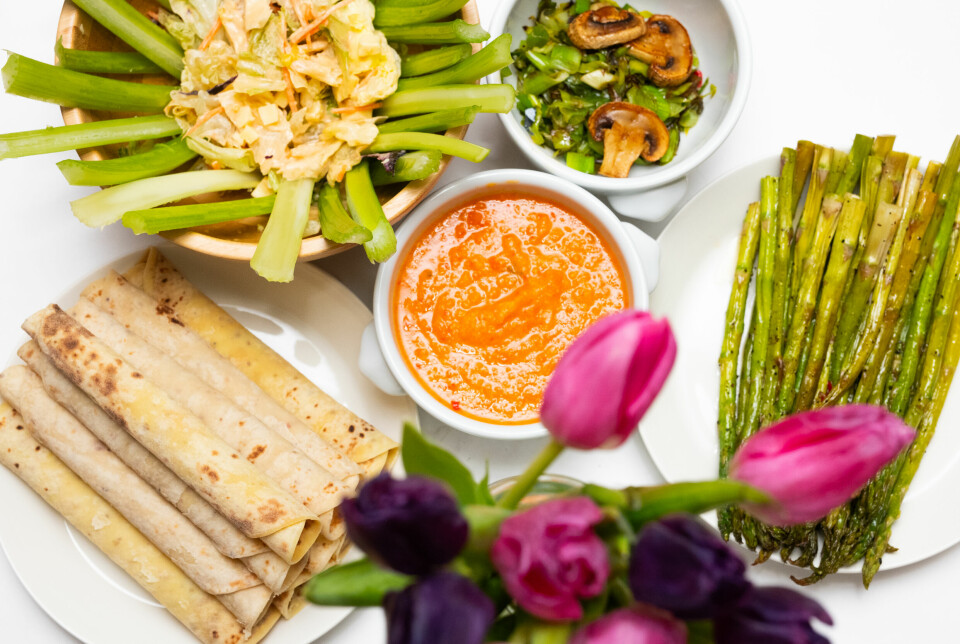
— So? Are you going to dumpster dive again?
We look at each other and start laughing.
— Maybe, but not anytime soon, smiles Isabel, and I smile too.
After going over our tiring night, and calculating the cost benefit of the whole experiment, Universitas' dispatched junk-food hunters have come to the following conclusion: The amount of money saved per person for the food was NOK 112.75 per person, but NOK 50 of this was inedible tulips. So, deduct the tulips, and we gained NOK 62.75’s worth of food. But if you're a low-budget student with an empty fridge and a rumbling stomach, it's a fantastic opportunity to go and find edible food without paying anything for it. This is probably a good emergency solution for those that are really struggling to make ends meet. But for everyone else, the winnings probably aren’t worth the tiring journey. My final tip for the students who want to experiment with dumpster diving: All fjellvettreglene (a famous list of hiking advice in Norway) apply, especially "there's no shame in turning back."

































